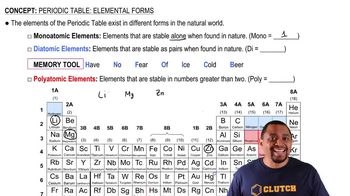Here are the essential concepts you must grasp in order to answer the question correctly.
Ionization Energy
Ionization energy is the energy required to remove an electron from an atom in its gaseous state. It is a key indicator of an element's reactivity and can vary significantly among different elements. Generally, ionization energy increases across a period due to increasing nuclear charge and decreases down a group due to increased electron shielding.
Recommended video:
Trends in Ionization Energies
The trends in ionization energies across the periodic table reveal that elements in the same group have lower ionization energies than those in the same period. As you move from left to right across a period, the ionization energy increases due to the greater effective nuclear charge experienced by the outer electrons. A large jump in ionization energy values indicates the removal of an electron from a much more stable electron configuration, often suggesting the element is nearing a noble gas configuration.
Recommended video:
Second-Row Elements
Second-row elements refer to the elements in the second period of the periodic table, which includes lithium (Li) to neon (Ne). These elements exhibit distinct chemical properties and trends in ionization energy, electronegativity, and atomic size. Understanding the specific ionization energies of these elements helps in identifying their identity based on the energy required to remove successive electrons.
Recommended video:
Elemental Forms of Elements
 McMurry 8th Edition
McMurry 8th Edition Ch.6 - Ionic Compounds: Periodic Trends and Bonding Theory
Ch.6 - Ionic Compounds: Periodic Trends and Bonding Theory Problem 65
Problem 65 Verified step by step guidance
Verified step by step guidance

